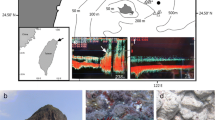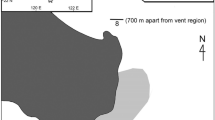Abstract
Stable isotopic analyses were used to study trophic relationships in two communities of deep-sea hydrothermal vent organism in the Pacific Ocean. The community at Hanging Gardens on the East Pacific Rise (21°N), sampled in 1985, is dominated by two species of vestimentiferan tubeworms; communities at Alice Springs and Snail Pits on the Marianas Back Arc Spreading Center (western Pacific), sampled in 1987, are dominated by gastropod mollusks, barnacles, and anemones. In both locations, carbon and nitrogen isotopic values of vent invertebrates are significantly different from those of non-vent invertebrates collected at 11°N on the East Pacific Rise and elsewhere in the deep-sea. These distinct isotopic compositions reflect local sources of organic carbon and nitrogen used by vent consumers. Many vent invertebrates lacking chemoautotrophic endosymbionts have 13C-enriched values of-11 to-16%. compared to values of-17 to-22%. normally observed in deep-sea fauna. This suggests that a 13C-enriched food source is trophically important in both vent communities. Free-living bacteria colonizing surfaces and suspended in the water column may constitute this food resource. Nitrogen isotopic analyses show that the food web of the East Pacific Rise community has more trophic levels than the Marianas vent community.
Similar content being viewed by others
Literature cited
Berg, C. J., Van Dover, C. L. (1987). Benthopelagic macrozooplankton communities at and near deep-sea hydrothermal vents in the eastern Pacific Ocean and the Gulf of California. Deep-Sea Res. 34: 379–401
Brooks, J. M., Kennicutt Jr M. C., Fisher, C. R., Macko, S. A., Cole, K., Childress, J. J., Bidigare, R. R., Vetter, R. D. (1987). Deep-sea hydrothermal seep communities: evidence for energy and nutritional carbon sources. Science, N.Y. 238: 1138–1142
Calder, J. A., Parker, P. L. (1973). Geochemical implications of induced changes in 13C fractionation by blue-green algae. Geochim. cosmochim. Acta 37: 133–140
Childress, J. J., Fisher, C. R., Brooks, J. M., Kennicutt, M. C., Bidigare, R. R., Anderson, A. E. (1986). A methanotrophic marine molluscan (Bivalvia, Mytilidae) symbiosis: mussels fueled by gas. Science, N.Y. 233: 1306–1308
DeNiro, M. J., Epstein, S. (1978). Influence of diet on the distribution of carbon isotopes in animals. Geochim. cosmochim. Acta 42: 495–506
DeNiro, M. J., Epstein, S. (1981). Influence of diet on the distribution of nitrogen isotopes in animals. Geochim. cosmochim. Acta 45: 341–351
Desbruyères, D., Gaill, F., Laubier, L., Prieur, D., Rau, G. H. (1983). Unusual nutrition of the “Pompeii worm” Alvinella pompejana (polychaetous annelid) from a hydrothermal vent environment: SEM, TEM, 13C and 15N evidence. Marine Biology 75: 201–205
Fisher, C. R., Childress, J. J., Arp, A. J., Brooks, J. M., Distel, D., Dugan, J. A., Felbeck, H., Fritz, L. W., Hessler, R. R., Johnson, K. S., Kennicutt, M. C., Lutz, R. A., Macko, S. A., Newton, A., Powell, M. A., Somero, G. N., Soto, T. (1988a). Variation in hydrothermal vent clam, Calyptogena magnifica, at the Rose Garden vent on the Galapagos spreading center. Deep-Sea Res. 35: 1811–1832
Fisher, C. R., Childress, J. J., Arp, A. J., Brooks, J. M., Distel, D., Favuzzi, J. A., Felbeck, H., Hessler, R. R., Johnson, K. S., Kennicutt, M. C., Macko, S. A., Newton, A., Powell, M. A., Somero, G. N., Soto, T. (1988 b). Microhabitat variation in the hydrothermal vent mussel, Bathymodiolus thermophilus, at the Rose Garden vent on the Galapagos Rift. Deep-Sea Res. 35: 1769–1792
Fisher, C. R., Childress, J. J., Arp, A. J., Brooks, J. M., Distel, D., Favuzzi, J. A., Macko, S. A., Newton, A., Powell, M. A., Somero, G. N., Soto, T. (1988c). Physiology, morphology, and biochemical composition of Riftia pachyptila at Rose Garden in 1985. Deep-Sea Res. 35: 1745–1758
Fry, B. (1988). Food web structure on Georges Bank from stable C, N, and S isotopic compositions. Limnol. Oceanogr. 33: 1182–1190
Fry, B., Anderson, R. K., Entzeroth, L., Bird, J. L., Parker, P. L. (1984). 13C enrichment and oceanic food web structure in the northwestern Gulf of Mexico. Contr. mar. Sci. Univ. Tex. 27: 49–63
Fry, B., Sherr, E. (1984). δ13C measurements as indicators of carbon flow in marine and freshwater ecosystems. Contr. mar. Sci. Univ. Tex. 27: 13–47
Hessler, R. R., Lonsdale, P., Hawkins, J. (1988). Patterns on the ocean floor. New Scient. 117: 47–51
Hessler, R. R., Smithey W. M. (1983). The distribution and community structure of megafauna at the Galapagos Rift hydrothermal vents. In: Rona, P. A., Bostrom, K., Laubier, L., Smith, K. L. (eds.) Hydrothermal Processes at Seafloor Spreading Centers, p. 735–770, Plenum Press, New York
Karl, D. (1987). Bacterial production at deep-sea hydrothermal vents and cold seeps: evidence for chemosynthetic primary production. In: Fletcher, M., Gray, T. R. G., Jones, J. G. (eds.) Ecology of Microbial Communities, (SGM Symposium 41) Cambridge University Press, New York, p 319–360
Minagawa, M., Wada, E. (1984). Stepwise enrichment of 15N along food chains: further evidence and the relation between 15N and animal age. Geochim. cosmochim. Acta 48: 1135–1140
Minagawa, M., Winter, D. A., Kaplan, I. R. (1984) Comparison of Kjeldahl and combustion methods for measurement of nitrogen isotope ratios in organic matter. Analyt. Chem. 56: 1859–1861
Mullin, M. M., Rau, g. H., Eppley, R. W. (1984) Stable nitrogen isotopes in zooplankton: some geographic and temporal variations in the North Pacific. Limnol. Oceanogr. 29: 1267–1273
Rau, G. H. (1981a). Low 15N/14N in hydrothermal vent animals: ecological implications. Nature, Lond. 289: 484–485
Rau, G. H. (1981b). Hydrothermal vent clam and tube worm 13C/12C: further evidence of nonphotosynthetic food sources. Science, N.Y. 213: 338–340
Rau, G. H. (1982). The relationship between trophic level and stable isotopes of carbon and nitrogen. In: Southern California Coastal Water Research Project Biennial Report 1981–1982. SCCWRP, Long Beach, p 143–148
Rau, G. H. (1985). 13C/12C and 15N/14N in hydrothermal vent organisms: ecological and biogeochemical implications. Bull. Biol. Soc. Wash. 6: 243–247
Rau, G. H., Hedges, J. I. (1979). Carbon-13 depletion in a hydrothermal vent mussel: suggestion of a chemosynthetic food source. Science, N.Y. 203: 648–649
Rau, G. H., Sweeny, R. E., Kaplan, I. R. (1982). Plankton 13C:12C ratio changes with latitude: differences between northern and southern oceans. Deep-Sea Res. 29: 1035–1039
Ruby, E. G., Jannasch, W. H., Deuser, W. (1987). Fractionation of stable carbon isotopes during chemoautotrophic growth of sulfur-oxidizing bacteria. Appl. envir. Microbiol. 53: 1940–1943
Saino, T., Hattori, A. (1987). Geographical variation of the water column distribution of suspended particulate organic nitrogen and its 15N natural abundance in the Pacific and its marginal seas. Deep-Sea Res. 34: 807–827
Schidlowski, M., Matzigkeit, U., Krumbein, W. E. (1984). Superheavy organic carbon from hypersaline microbial mats. Naturwissenschaften 71: 303–308
Southward, A. J., Southward, E. C., Dando, P. R., rau, G. H., Felbeck, H., Flugel, H. (1981). Bacterial symbionts and low 13C/12C ratios in tissues of Pogonophora indicate unusual nutrition and metabolism. Nature, Lond. 293: 616–620
Stein, J. L., Cary, S. C., Childress, J. J., Hessler, R. R., Ohta, S., Vetter, R. D., Felbeck, H. (1988). Chemoautotrophic symbiosis in a hydrothermal vent gastropod. Biol. Bull. mar. biol. Lab., Woods Hole 174: 373–378
Van Dover, C. L., Fry, B., Grassle, J. F., Humphris, S., Rona, P. A. (1988). Feeding biology of the shrimp Rimicaris exoculata at hydrothermal vents on the Mid-Atlantic Ridge. Mar. Biol. 98: 209–216
Van Dover, C. L., Lichtwardt, R. W. (1986). A new trichomycete commensal with a galatheid squat lobster from deep-sea hydrothermal vents. Biol. Bull. mar. biol. Lab., Woods Hole 171: 461–468
Wada, E., Terazaki, M., Kabaya, Y., Nemoto, T. (1987). 15N and 13C abundances in the Antarctic Ocean with emphasis on the biogeochemical structure of the food web. Deep-Sea Res. 34: 829–841
Williams, P. M., Druffel, E. M., Smith, K. L. (1987). Dietary carbon sources for deep-sea organisms as inferred from their organic radiocarbon activities. Deep-Sea Res. 34: 253–266
Williams, P. M., Smith, K. L., Druffel, E. M., Linick, T. W. (1981). Dietary carbon sources of mussels and tubeworms from Galapagos hydrothermal vents determined from tissue 14C. Nature, Lond. 292: 448–449
Author information
Authors and Affiliations
Additional information
Communicated by J. Grassle, Woods Hole
Rights and permissions
About this article
Cite this article
Van Dover, C.L., Fry, B. Stable isotopic compositions of hydrothermal vent organisms. Mar. Biol. 102, 257–263 (1989). https://doi.org/10.1007/BF00428287
Accepted:
Issue Date:
DOI: https://doi.org/10.1007/BF00428287




